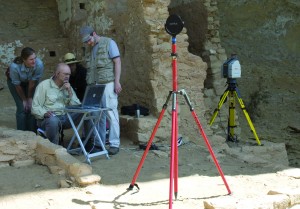New methods could speed archeological documentation time by 60 percent

Thousands of ruins at National Parks face severe deterioration and collapse. “Vanishing Treasures” is a grass-roots program that brings attention to these resources, and to the loss of expertise within NPS to deal with the crisis. Emerging high definition methods pioneered by CyArk are offering Vanishing Treasures personnel an edge in their documentation efforts.
Documenting archeological sites has traditionally been a painstaking manual process requiring significant investments in time and personnel that few national parks have. As a result, parks like Mesa Verde are losing cultural heritage sites faster than they can document them.
A recent PTT Grant project furthers the use of high definition technology to make the documentation process simpler, cheaper and more accurate. John Loomis of the CyArk 3D Heritage Archive Network served as principal investigator on the project. He believes the high definition documentation methods his research group is modeling at Mesa Verde National Park have the potential to optimize human and financial resources through training sessions and workshops to park personnel.
“The raw data collected will benefit researchers, scientists and the general public through a database of world heritage information on the Internet”
“Faster tools and processes are urgently needed to document heritage sites, and archive their data into a modern database information system,” Loomis said. “An integrated use of high definition laser scanning and high resolution, high dynamic range photography, and other advanced tools for acquiring field data known as High Definition Documentation (HDD) are the solution to this problem, and have proven to speed up the documentation process by 60 percent.”
Considering the documentation needs nationally, speed is of the essence. Loomis and his colleagues chose Mesa Verde because it has over 2,000 archeological sites, of which 700 are some form of cliff dwelling. This project marks the first time HDD has been used on a large scale at a U.S. National Park. Additionally, it is the first time that a park staff is being trained and involved in the process.
The project began as an extension of a three-year collaborative effort between CyArk, Texas Tech University and the University of California, Berkeley, to develop and apply HDD at Mesa Verde. Texas Tech first received a PTT grant and CyArk later received a grant to aid the dissemination of the HDD technology and processes to Mesa Verde park staff, and by extension disseminate them to other sites.
“The raw data collected will benefit researchers, scientists and the general public through a database of world heritage information on the Internet,” Loomis said. “High definition documentation and photography will also produce data that can be transferred directly into virtual interpretation media, such as virtual dioramas, panoramas, animations, virtual reconstructions, and real-time walkthroughs.”
The project researchers plan to further develop and test out the training model at Mesa Verde, eventually extending it to other interested U.S. National Parks and possibly to the international Sister Cultural Parks program in which Mesa Verde is taking a leading role.
No related posts.


